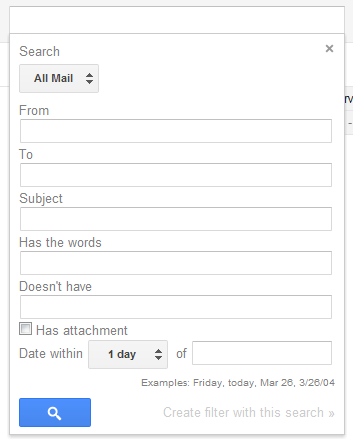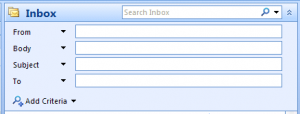Day 3: Learn How to Search for Email
Using the search function is the fastest way to find the email that you need.
Sometimes finding an email you need is like finding the matches. You see that box of matches all the time around the house when you don't need it, but when the electricity goes out, it's nowhere to be found. Emails have a way of doing the same. When you don't need a message, you can't avoid seeing it in your inbox. But it will magically hide from you when you go looking for it.
Everyone has his own personal technique to find messages that he's looking for. Some start with folders and labels. Some go straight to sorting messages and scanning individual folders and messages. Some use the search box first but fall back to sorting and scanning when the search doesn't turn up what they're looking for. All these individual techniques have been ingrained because people can't trust that the email client's search functionality will locate the messages they need. Worry no more - we have some good news for you.
Email clients have gotten a lot smarter over the last 10 years, especially their search features. Thanks to the power of search, locating emails is easier than ever. With the right search terms, you should be able to find the specific email that you're looking for in 5 seconds or less. Today, we'll show you how to search effectively, and we hope that over time, you will start to trust the search functionality completely.
Here are some of the more useful basic search keywords:
- from: - Search messages from a specific sender name or email address.
- has:attachment - Search for messages that have files attached to them
- label: - Search for messages within a certain label, using hyphens between words for multi-word labels (Gmail only)
- before: - Search for messages sent before a date
- filename: - Search for file names of attachments or file name extensions (i.e. jpg or doc)
Since the exact commands differ from client to client, we made a couple of handy cheat sheets for Gmail and Outlook. Go ahead and download the cheat sheet for your email client, print it out, and keep it on your desk for the next week.
Need even more power? You can easily try more advanced searches (and find other search parameters) by using your client's query builder. In Gmail (new look), click the downward arrow next to the search button.
A similar advanced search feature exists in Outlook. The exact location differs depending on which version of Outlook you are using, but you should see it either as a dropdown or a tab while typing into the search box, as shown below.
To do: Estimated Time: 10 min
- Print out the appropriate cheat sheet (Gmail or Outlook).
- Get comfortable with the search commands by trying out the examples below:
- Find all messages sent last week that has an attachment
- Find all messages that arrived before 2010
- Find all messages from your boss or your mom
- Search for all messages containing the term "presentation" with an attachment
- Search for all messages containing the exact phrase "please advise"
- Find all unread messages from yesterday
- Find messages that have the word "recommendation" in the subject
Keep in mind that using search effectively is in large part a muscle memory exercise. If you skip the practice searches above, the examples on the cheat sheet probably won't stick for very long. We know you're busy, but the practice is really important.
I searched, but it still won't show up
The default search in email clients often ignore messages in the Trash and Spam folders. In Gmail, remember to use the command "in:anywhere" to include Trash and Spam. In Outlook, access Search Options and check the setting that says "include messages from the Deleted Items folder".
Final Thoughts
| Searching is only used to find messages 18% of the time, despite being 2x as fast as any other method | Tweet |
| Learn how to search email effectively by downloading these Gmail and Outlook cheat sheets. | Tweet |
| If you can't find an email, don't forget to look in your Trash or Spam folders. | Tweet |
So far this week, we've worked on limiting email interruptions, reducing the amount of low-value email that comes into our lives, and now how to more effectively find messages after we've read them. Tomorrow starts a new phase of the program, where we'll talk about the changes that we need to make to prepare to learn a new email workflow.






